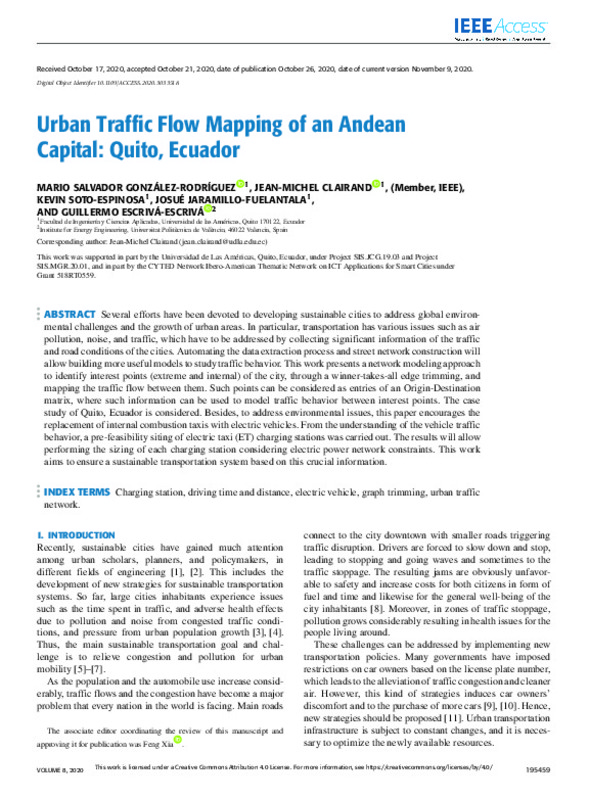González-Rodríguez, MS.; Clairand, J.; Soto-Espinosa, K.; Jaramillo-Fuelantala, J.; Escrivá-Escrivá, G. (2020). Urban Traffic Flow Mapping of an Andean Capital: Quito, Ecuador. IEEE Access. 8:195459-195471. https://doi.org/10.1109/ACCESS.2020.3033518
Por favor, use este identificador para citar o enlazar este ítem: http://hdl.handle.net/10251/168684
|
Título:
|
Urban Traffic Flow Mapping of an Andean Capital: Quito, Ecuador
|
|
Autor:
|
González-Rodríguez, Mario Salvador
Clairand, Jean-Michel
Soto-Espinosa, Kevin
Jaramillo-Fuelantala, Josué

 Escrivá-Escrivá, Guillermo
Escrivá-Escrivá, Guillermo
|
|
Entidad UPV:
|
Universitat Politècnica de València. Departamento de Ingeniería Eléctrica - Departament d'Enginyeria Elèctrica
|
|
Fecha difusión:
|
|
|
Resumen:
|
[EN] Several efforts have been devoted to developing sustainable cities to address global environmental challenges and the growth of urban areas. In particular, transportation has various issues such as air pollution, ...[+]
[EN] Several efforts have been devoted to developing sustainable cities to address global environmental challenges and the growth of urban areas. In particular, transportation has various issues such as air pollution, noise, and traffic, which have to be addressed by collecting significant information of the traffic and road conditions of the cities. Automating the data extraction process and street network construction will allow building more useful models to study traffic behavior. This work presents a network modeling approach to identify interest points (extreme and internal) of the city, through a winner-takes-all edge trimming, and mapping the traffic flow between them. Such points can be considered as entries of an Origin-Destination matrix, where such information can be used to model traffic behavior between interest points. The case study of Quito, Ecuador is considered. Besides, to address environmental issues, this paper encourages the replacement of internal combustion taxis with electric vehicles. From the understanding of the vehicle traffic behavior, a pre-feasibility siting of electric taxi (ET) charging stations was carried out. The results will allow performing the sizing of each charging station considering electric power network constraints. This work aims to ensure a sustainable transportation system based on this crucial information.
[-]
|
|
Palabras clave:
|
Urban areas
,
Charging stations
,
Public transportation
,
Data mining
,
Vehicles
,
Roads
,
Charging station
,
Driving time and distance
,
Electric vehicle
,
Graph trimming
,
Urban traffic network
|
|
Derechos de uso:
|
Reconocimiento (by)
|
|
Fuente:
|
IEEE Access. (eissn:
2169-3536
)
|
|
DOI:
|
10.1109/ACCESS.2020.3033518
|
|
Editorial:
|
Institute of Electrical and Electronics Engineers
|
|
Versión del editor:
|
https://doi.org/10.1109/ACCESS.2020.3033518
|
|
Código del Proyecto:
|
info:eu-repo/grantAgreement/UDLA//SIS.JCG.19.03/
info:eu-repo/grantAgreement/UDLA//SIS.MGR.20.01/
info:eu-repo/grantAgreement/CYTED//518RT0559//RED TEMÁTICA IBEROAMERICANA SOBRE APLICACIONES TICS PARA CIUDADES INTELIGENTES/TICS4CI/
|
|
Agradecimientos:
|
This work was supported in part by the Universidad de Las Americas, Quito, Ecuador, under Project SIS.JCG.19.03 and Project SIS.MGR.20.01, and in part by the CYTED Network Ibero-American Thematic Network on ICT Applications ...[+]
This work was supported in part by the Universidad de Las Americas, Quito, Ecuador, under Project SIS.JCG.19.03 and Project SIS.MGR.20.01, and in part by the CYTED Network Ibero-American Thematic Network on ICT Applications for Smart Cities under Grant 518RT0559.
[-]
|
|
Tipo:
|
Artículo
|









